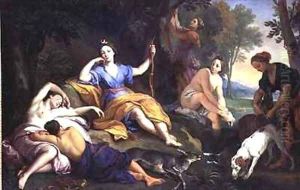Louis de (the Younger) Boullongne Paintings
Louis de Boullongne the Younger was a prominent French painter, born in 1654 in Paris, France. He was part of a significant family of artists; his father, Louis de Boullongne the Elder, was also a respected painter, and his siblings, including sister Geneviève Boullongne and brother Bon Boullongne, were accomplished artists as well. This familial environment immersed Louis the Younger in the world of art from a very young age, providing a fertile ground for his development as a painter.
Louis de Boullongne the Younger is known for his contributions to religious and mythological painting, showcasing a mastery of classical style that was prevalent during his time. His works often depicted scenes from the Bible as well as classical mythology, executed with a delicate sense of composition and a keen attention to detail. He was particularly adept at capturing the human form, imbuing his figures with a sense of grace and dynamism that was highly admired.
In 1678, Louis the Younger won the prestigious Prix de Rome, which awarded him the opportunity to study in Rome at the French Academy. His time in Italy had a profound impact on his artistic development, exposing him to the works of the Renaissance and Baroque masters. Upon his return to France, he quickly gained recognition and was admitted to the Royal Academy of Painting and Sculpture in 1681. His reputation continued to grow, and in 1722, he was appointed as the director of the French Academy in Rome, a position that attested to his stature in the European art world.
Throughout his career, Louis the Younger received numerous commissions from the French monarchy and the Catholic Church, contributing significantly to the artistic heritage of the Grand Siècle, or the Great Century, under the reign of Louis XIV. Despite the political and social changes that France underwent during his lifetime, including the transition to the reign of Louis XV, Boullongne's art remained a steadfast example of classical French painting.
Louis de Boullongne the Younger passed away in 1733 in Paris. His legacy is preserved through his contributions to the collections of many important museums and institutions. His work not only reflects the artistic ideals of his time but also provides insight into the rich cultural and historical context of late 17th and early 18th century France. As such, Louis de Boullongne the Younger remains an important figure in the history of French art, celebrated for his skill, his dedication to the classical tradition, and his influence on subsequent generations of artists.
